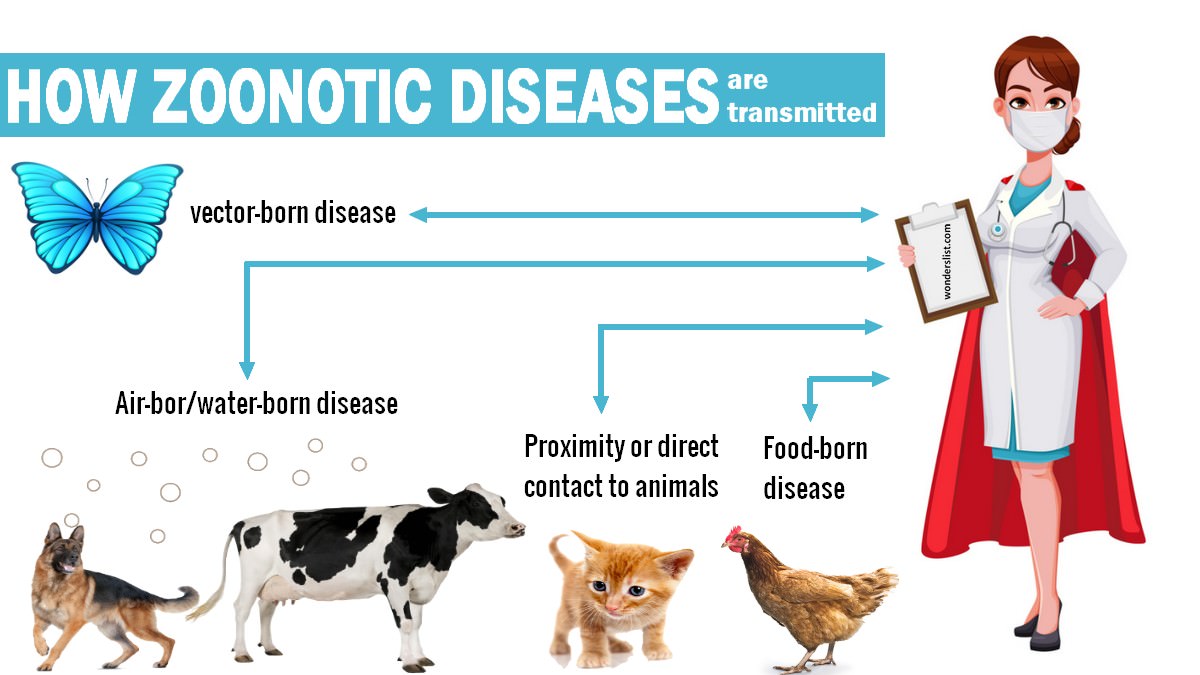Zoonotic disease are naturally transmitted from affected animal to human. Zoonotic disease are common through all over the world. Scientist estimate more than forty percent infection spread through domestic or wild animals. Numbers of parameter that can used to prevent from spreading of zoonotic diseases such as; Wearing of gloves while handling the infected animal. Justinian Plague first epidemic began in the middle of the 6th century in the Byzantine Empire.
Zoonotic disease may be spread through direct contact and body fluid such as blood saliva of an infected human or animal. Zoonotic disease can be transmitted through indirect contact for example; A person is bitten by arthropod vector such as mosquito that has picked up a pathogen from infected animals. Zoonotic disease cause by harmful germs like viruses, bacteria, parasite and fungi that may be ranging from mild infection to severe infection. It depend upon the germ severity like if a person bitten with a rabid dog, it would be lethal if treatment not started timely.

Most Common Zoonotic Diseases: Disease Transmitted from Animals to Humans.
1. Rabies
It is a viral infection caused by Lyssa virus in the Rhabdovirus family. Transmission of virus through saliva of infected animal into tissue which lead to inflammation of brain. It could be fatal if treatment protocol did not follow properly.
Initially it has been started from fever and tingling at the site of exposure. Uncontrolled excitement, irregular movement, fear from water and loss of consciousness. Incubation period may b four days to six year depends upon location of wound and amount of virus introduce.
Ninety percent rabies spread in human through the bite of domestic canine breed. Recommended vaccination in domestic animals covered said risk up to ninety percent. An immunologically technique is required to identify rabies antigen (FAT). Only treatment solution is rabies vaccination protocol.
Immediate step that had to be taken in case of animal bite, wash the affected area with disinfected solution for five to ten minutes and apply bandage. Call the animal owner and ask about the vaccination schedule of pet. Immediately consult with your physician.
2. Anthrax disease
It is a bacterial infection cause by Bacillus anthracis that can be transmitted direct or indirect contact to infected animal. There are four farms of human anthrax infection; Skin, gastro intestinal, lung and injection.
Cutaneous anthracis is when anthrax occurs on skin. It is most common farm with low mortality and present as a boil-like skin lesion. Outbreak of anthrax among injection heroin in the Glasgow December 2009, resulting 14 deaths.
Diagnosed may be conducting through lab test, computed tomography, chest X-ray and biopsy of skin lesion.
3. Pasteurellosis
It is a zoonotic disease caused by the infection with bacteria of Pasteurella genus. Pasteurella multocida most common bacteria reported in this group normally found in the upper respiratory tract o all species. It is transmitted by animal bites, scratches and lead to meningitis, ocular infection and respiratory infection.
Diagnosis on the basis of lab test and immediate treatment clean the infection with disinfectant and take prescribe antibiotic.
4. Listeriosis
A food born disease caused by bacteria Listeria monoytogenes that act as an intracellular parasite. It could be fatal in case of meningitis and septicemia. It is transmitted through different routes, but it can be transferred among the people during sexual activity. Most susceptible people are pregnant women, new born and people who had weak immune system.
Diagnose on the basis of blood test and cerebrospinal fluid in the presence of bacteria. Antibiotic may help in the recovery of infection.
5. Cat scratch disease (CSD)
It is a bacterial disease caused by Bartonella henselae that often result from scratch or bite of a cat. Also, it is generally transmitted though contact with flea feces. Typically symptoms are swelling of lymph node nearest to the scratch site, headache, fever and reproductive difficulty.
Properly diagnosed on the basis of isolation and identification of bacterium. Wound site should be clean thoroughly. And antimicrobial therapy may be used. Affected person should stay way with young cats.
6. Q fever
Query fever is a disease caused by with Coxiella burnetti. It is transmitted through blood transfusion and sex. People may affected by breathing in dust that has been contaminated milk, urine and birth product.
Q-fever cause flue like symptoms. Recovery may be possible on their own but through antibiotic it will helpful to avoid secondary infection. Blood test can diagnose Q-fever.
7. Cryptococcus
It is an infectious fungal disease caused by a pathogen that may jump from animal to human. It is fatal fungal infection that damage lungs may lead to pneumonia and meningitis. The main source of spreading of this disease through inhalation of fungus that is found in many birds faces. Treatment started from antifungal medicine (itraconazole, fluconazole).
8. Lassa fever (LHF)
It is a viral hemorrhagic fever caused by Lassa virus. Rodent shed the virus through urine and dropping, direct contact to materials and through inhalation and ingestion. Mild symptom includes; Fever, weakness and headache.
Diagnosed by using enzyme –link immunosorbent serologic assays (ELISA). PCR technique may also used in case of early infection. Therefore, avoid from direct contact to infected person by taking preventive precaution.
9. Crimean-Congo hemorrhages fever (CCHF)
It is a viral hemorrhages fever caused by a virus Nairo virus group. It is spread via a bite of infected tick and direct contact with blood and body fluid. Sign symptom; Neck pain and stiffness, petechial rash and bleeding of the gum. Diagnosed with PCR for nucleic acid detection, virus isolation and antibody detection method.
10. Rift valley fever (RVF)
It is one of the most common viral zoonotic diseases. Also it can be transmitted through blood and organ of infected animals. The incubation period of RVF varies 6-10 days. This disease usually appears in three forms; Occulr, Hemorrhgic and Meningoencephalitis form. Diagnosed this disease through PCR and ELISA test.






